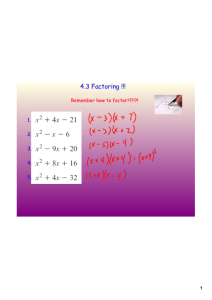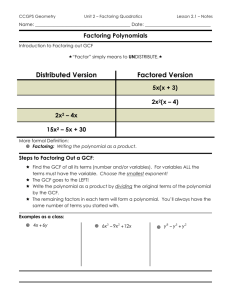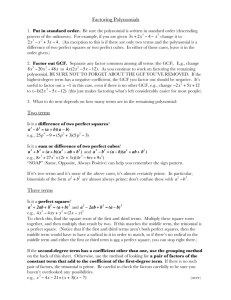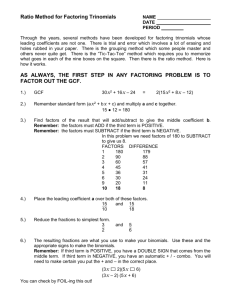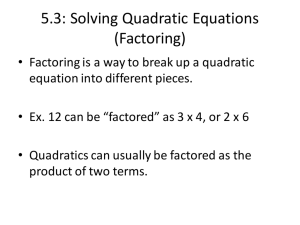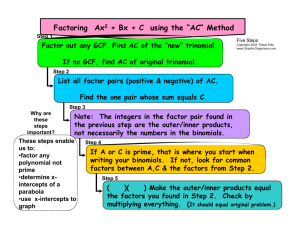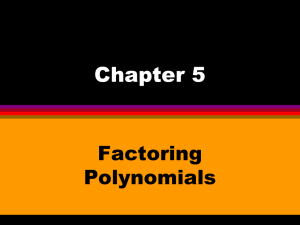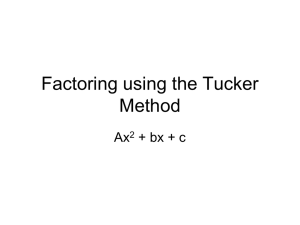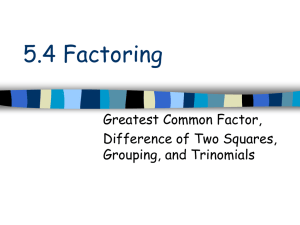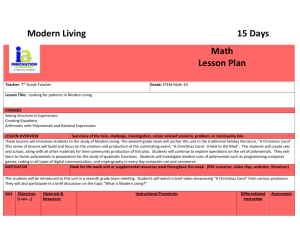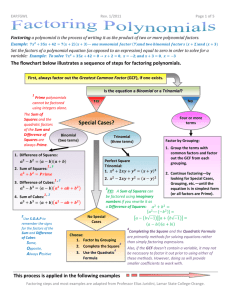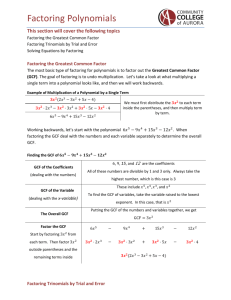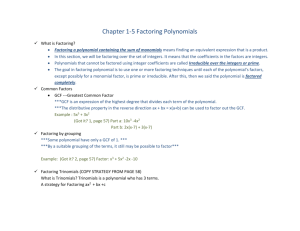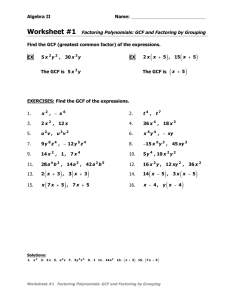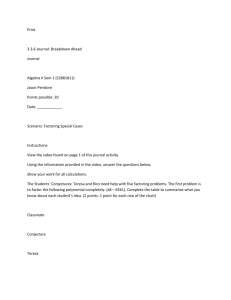Factoring Tutorial - Boone County Schools
advertisement
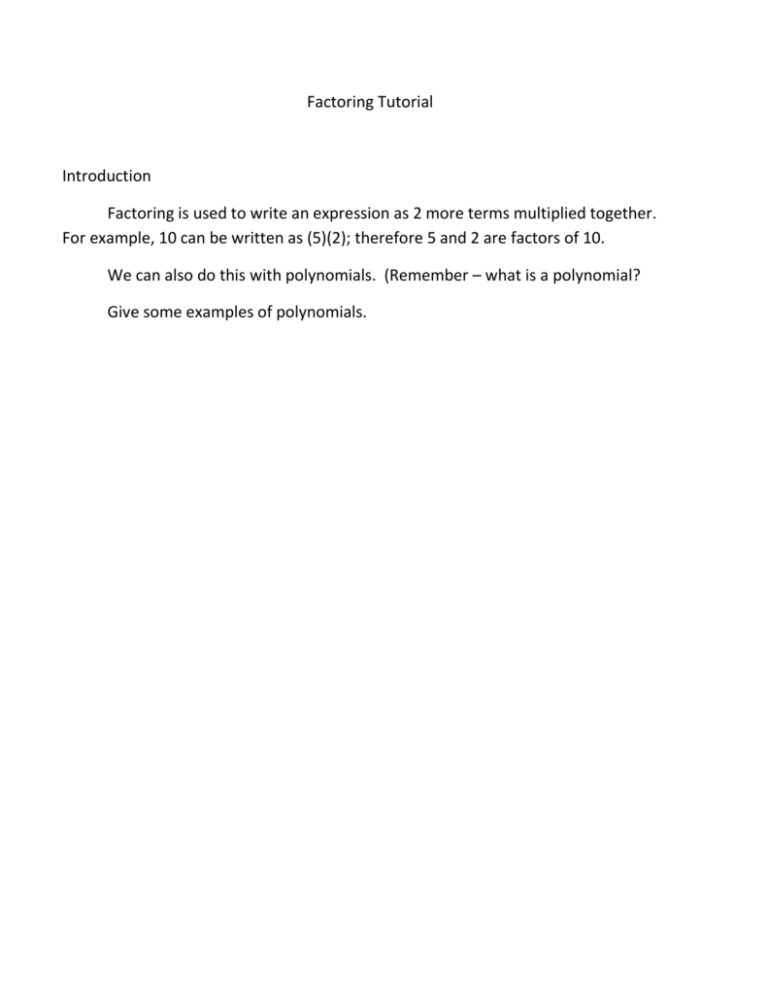
Factoring Tutorial Introduction Factoring is used to write an expression as 2 more terms multiplied together. For example, 10 can be written as (5)(2); therefore 5 and 2 are factors of 10. We can also do this with polynomials. (Remember – what is a polynomial? Give some examples of polynomials. Greatest Common Factors What is a common factor? A common factor is one number or expression that will divide into several numbers or expressions. Example 1: 25 35 What number divides into both 25 and 35? Example 2: 14𝑦 5 − 4𝑦 3 + 2𝑦 What monomial will divide into all 3 terms? Divide each term by the GCF. Write the GCF and remaining polynomial as a product. ***Alert – If the term of the polynomial is exactly the same as the GCF, when you divide, you are left with 1, not zero. Example 3: 𝑥(3𝑥 − 1) + 5(3𝑥 − 1) What is the GCF? Factor it out of the polynomial. Factoring a Polynomial with 4 Terms By Grouping Sometimes there is not a GCF for all the terms in a polynomial. If you have 4 terms, try grouping them. a. Group the 1st 2 terms together and the last 2 terms together. b. Factor out a GCF for the first set and a GCF from the second set. c. Factor out a common binomial if possible. Example 4: 𝑥 3 + 3𝑥 2 + 2𝑥 + 6 Example 5: 7𝑥 3 − 14𝑥 2 − 𝑥 + 2 Factoring Trinomials Where The Leading Coefficient is 1 𝑥 2 + 𝑏𝑥 + 𝑐 To factor this quadratic expression, students need to find the 2 x-terms that multiply together to equal 𝑥 2 times 8. (The product of the diagonals of the rectangle should be equal.) Also, the sum of the 2 x-terms is b. Check this concept by examining the rectangle at the top of this page. Example 6: Find the 2 terms whose product is 12𝑥 2 and whose sum is 7𝑥 . Write these terms in the other diagonal. It doesn’t matter which one goes where. Factor a GCF out of each row and column. (Find the dimensions of each side of the rectangle.) Write the completed factored form. Example 7: Factor 𝑥 2 + 7𝑥 − 30 Example 8: Factor 𝑥 2 − 15𝑥 + 56 Factoring Trinomials of the Form 𝑎𝑥 2 + 𝑏𝑥 + 𝑐 Use the same method as before – a rectangle model. Example 9: Factor the GCF for each row and column. Check the signs of each factor. Write the completed factored form. Example 10: Factor 3𝑥 2 + 21𝑥 + 36 Note: If a common factor appears in all the terms, it should be factored out first. Then follow the previous examples. Factoring a Perfect Square Trinomial 𝑎2 + 2𝑎𝑏 + 𝑏 2 = (𝑎 + 𝑏)2 OR 𝑎2 − 2𝑎𝑏 + 𝑏 2 = (𝑎 − 𝑏)2 The trinomial must be in this exact form. If you aren’t sure, you can use the general process for factoring. Example 11: 𝑦 2 + 14𝑦 + 49 Example 12: 9𝑥 2 − 30𝑥𝑦 + 25𝑦 2 Factoring a Difference of Two Squares 𝑥 2 − 𝑎2 = (𝑥 + 𝑎)(𝑥 − 𝑎) ***Alert – the sum of 2 perfect squares does not factor. The difference of 2 squares must be in exactly this form. Example 13: 𝑦 2 − 16 Example 14: 25𝑥 2 − 81 Factoring a Sum of Two Cubes Factoring a Difference of Two Cubes 𝑥 3 + 𝑎3 = (𝑥 + 𝑎)(𝑥 2 − 𝑎𝑥 + 𝑎2 ) 𝑥 3 − 𝑎3 = (𝑥 − 𝑎)(𝑥 2 + 𝑎𝑥 + 𝑎2 ) To use this rule, the polynomial must be in one of these exact forms. Example 15: 64𝑎3 + 1 Example 16: 27𝑥 3 − 8 Put it all Together: Examples of Many Kinds Example 17: 27𝑎2 + 36𝑎 + 12 Example 18: 𝑦 4 − 16 Example 19: 𝑥 3 + 64𝑦 3 Example 20: 6𝑥 2 − 17𝑥 + 5 Example 21: 𝑥 2 + 5𝑏𝑥 − 2𝑎𝑥 − 10𝑎𝑏
